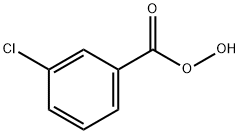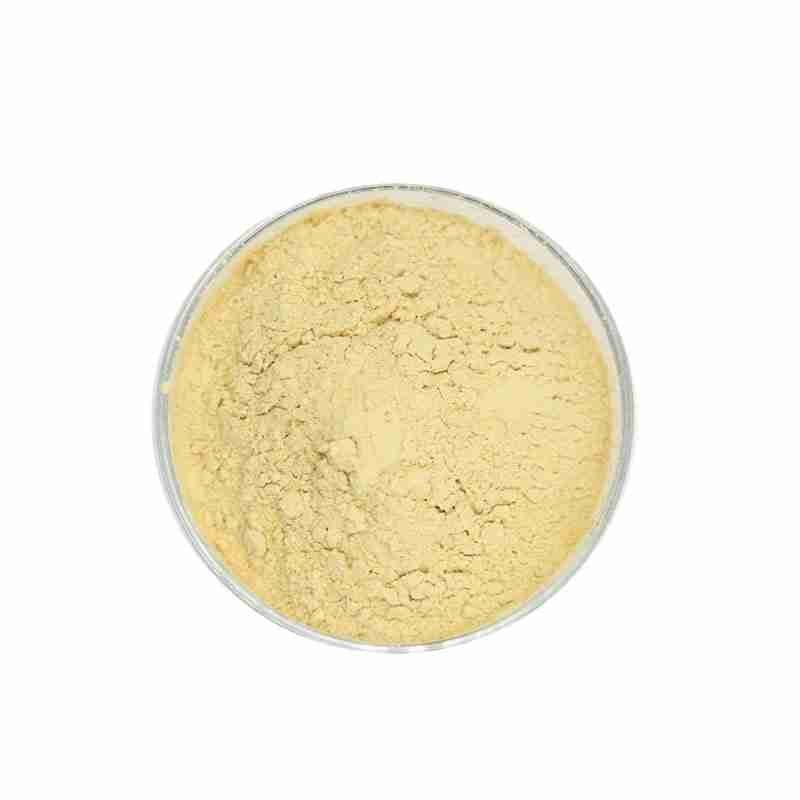3-Chloroperoxybenzoic Acid CAS# 937-14-4
3-Chloroperoxybenzoic acid (m-CPBA) is a carboxylic acid derivative, a white powder crystal, almost insoluble in water, conveniently soluble in ethanol, ether, soluble in chloroform, dichloroethane. Steady to warm, the annual disintegration price is listed below 1% at room temperature level. Disintegration rate is accelerated in liquid state.
In a polyethylene container, include 1.5 g of magnesium sulfate heptahydrate, 36g of sodium hydroxide, 360ml of water, 90ml of 30% hydrogen peroxide, 450ml of dioxane as well as ice cubes, reduced the temperature level to 15 ?? C, as well as include 52.5 g of M-chlorobenzoyl chloride, after that include ice to keep the temperature level listed below 25 ?? C. After reacting for 15 mins, include 900ml of 20% chilly sulfuric acid. After standing still, the organic layer was divided, filteringed system, and the filtrate was evaporated to eliminate the solvent (high vacuum cleaner distillation) to get 51g of 3-chloroperbenzoic acid.
发送询盘
3-Chloroperoxybenzoic Acid CAS# 937-14-4
| 3-Chloroperoxybenzoic acid Basic information |
| Chemical Properties?Uses |
| Product Name: | 3-Chloroperoxybenzoic acid |
| Synonyms: | 3-CHLOROPEROXYBENZOIC ACID;3-Chloroperoxy benzoic acid(more than 57% but not more than 86%,with 3-chorobenzoic acid);3-Chloroperoxybenzoic acid, balance 3-Chlorobenzoic acid and water, 70-75%;3-Chloroperoxybenzoic acid, 70 – 75%, (balance 3-chlorobenzoic acid and water);3-Chlorobenzeneperoxycarboxylic acid;3-Chloroperoxybenzoic Acid (contains min. 17% Water and min. 6% 3-Chlorobenzoic Acid);3-Chloroperoxybenzoic Acid (contains ca. 30% Water);3-Chloroperoxybenzoic acid ,75% |
| CAS: | 937-14-4 |
| MF: | C7H5ClO3 |
| MW: | 172.57 |
| EINECS: | 213-322-3 |
| Product Categories: | Organic Peroxide;Oxidation;Synthetic Organic Chemistry;Organic acids;PHARMACEUTICAL INTERMEDIATES;Aromatics;bc0001;top |
| Mol File: | 937-14-4.mol |
 |
|
| 3-Chloroperoxybenzoic acid Chemical Properties |
| Melting point | 69-71???C(lit.) |
| Boiling point | 244.67??C (rough estimate) |
| density | 0.56 |
| vapor pressure | 0.373Pa at 25?? |
| refractive index | 1.4580 (estimate) |
| storage temp. | 2-8??C |
| solubility | Chloroform (Slightly), Ethyl Acetate (Slightly), Methanol (Slightly) |
| pka | 7.57 (in water @ 25 ??C) |
| form | Moist Powder |
| color | White |
| PH | 4.5@25 ??C (saturated aq. sol) |
| Odor | slight pungent odor |
| Water Solubility | insoluble |
| Decomposition | >88 ??C |
| BRN | 608317 |
| Stability: | Strong oxidizing agent – contact with combustible material may cause fire. May be shock or heat sensitive. Incompatible with organic materials, strong reducing agents. |
| InChIKey | NHQDETIJWKXCTC-UHFFFAOYSA-N |
| LogP | 1.03 at 25?? |
| CAS DataBase Reference | 937-14-4(CAS DataBase Reference) |
| NIST Chemistry Reference | 3-Chloroperbenzoic acid(937-14-4) |
| EPA Substance Registry System | Benzenecarboperoxoic acid, 3-chloro- (937-14-4) |
- 2
- 2-diallylpent-4-en-1-amine
- 4
- 95-16-9
- Ammonium sulfamate
- Benzothiazole
- cas:67889-00-3ح2
- cas:83524-75-8 | pigment black 32
- cas:928836-00-4 | 2
- cas:932745-70-5 | 4
- Chemical Minerals
- Coconut diethanolamide
- Daily Chemicals
- discount
- for sale
- General pvc resin
- hexyl D-glucoside
- in stock
- Lauramidopropyl betaine
- LAURIC ACID MONOETHANOLAMIDE
- Petroleum Additives
- Plasticiser
- Ploymers
- price
- PVC
- quotation
- Raw Materal
- Remove term: Petroleum Additives Petroleum Additive
- SODIUM ETHYL 2-SULFOLAURATE
Related Products
Butylated Hydroxytoluene (BHT) is a synthetic phenolic antioxidant commonly added to foods, cosmetics, and packaging to prevent the oxidation of fats and oils, thereby extending their shelf life. It is also used as a preservative in a variety of products, including rubber, petroleum products, and animal feed. BHT is recognized for its effectiveness in maintaining nutrient levels, color, flavor, and odor in food products . It is known to have a melting point of 69-71??C, a boiling point of 265??C, and is soluble in ethanol, acetone, and benzene, but not in water, glycerin, or propylene glycol . BHT is also used in some dietary supplements due to its antioxidant properties . However, it is important to handle BHT with care, as it can cause skin irritation and is considered harmful if swallowed .
Tetraacetylethylenediamine is a fully acetylated derivative of ethylenediamine, offering a high reactivity as an intermediate in organic synthesis. Its unique structure makes it a critical component in the production of specialty chemicals and pharmaceuticals, ensuring a wide range of applications in the chemical industry.
Chemical Name: Zinc citrate
Synonyms: Zinc citrate trihydrate
CAS No.: 546-46-3
Molecular Formula: C6H8O7Zn
Molecular Weight: 257.5
Appearance: White powder
Chemical Name: Choline salicylate
CAS No.: 2016-36-6
Molecular Formula: C12H19NO4
Molecular Weight: 241.28
Appearance: Red-Brown Crystal
Chemical Name: Dehydrocholic acid
Synonyms: Acide dehydrocholique; Triketocholanic acid
CAS No.: 81-23-2
Molecular Formula: C24H34O5
Molecular Weight: 402.53
Appearance: Powder
Chemical Name: STODDARD SOLVENT
CAS No.: 64742-88-7
Appearance: Colorless or Light Yellow Liquid
Benzothiazoles are a class of chemical compounds characterized by a fused benzene and thiazole ring. They exhibit a broad spectrum of applications, particularly as antioxidants in rubber and plastic industries, enhancing product longevity and performance. Additionally, benzothiazoles serve as key intermediates in the synthesis of pharmaceuticals, contributing to the development of life-saving drugs. Recognized for their stability and reactivity, these compounds are integral to advancing material science and healthcare solutions.
Chemical Name: UV-120
Other Name: (2’,4’-Di-tert-butylphenyl 3,5-di-tert-butyl-4-hydroxybenzoate)
CAS No.: 4221-80-1
Molecular Fomula: C29H42O3
Molecular weight: 438.66
Assay: ≥99%(LC)
Chemical Name: Potassium Castorate
CAS No.: 8013-05-6
Molecular Formula: C57H107K3O12
Molecular Weight: 1101.74718
Appearance: Yellow Liquid
Ethylhexyl Palmitate is a skin-conditioning ester, derived from ethylhexanol and palmitic acid, that imparts moisturization and a smooth texture to cosmetic and personal care formulations. It is valued for its emollient properties, enhancing the sensory experience of skin care products.
Chemical Name: o-Xylene
Synonyms: 1,2-Dimethylbenzene; ortho-xylene
CAS No.: 95-47-6
Molecular Formula: C8H10
Molecular Weight: 106.17
Octocrylene is an organic compound widely recognized for its potent UV-filtering properties, making it an essential ingredient in sunscreens and other skincare products designed to protect the skin from harmful ultraviolet radiation. With the chemical name 2-(4-Methylbenzyl)-2H-benzotriazole-5-methyl, octocrylene is a stable and photostable molecule that provides broad-spectrum protection against both UVA and UVB rays.
This oil-soluble chemical is valued for its ability to absorb UV radiation effectively, converting it into heat without causing skin irritation or staining clothes. Octocrylene is often used in combination with other UV filters to enhance the sun protection factor (SPF) of formulations, ensuring a balanced and comprehensive defense against sun damage.
As a lipophilic compound, octocrylene is compatible with various cosmetic and dermatological formulations, contributing to the development of lightweight, non-greasy sunscreens. Its chemical structure allows for a high degree of safety and efficacy, making it suitable for a wide range of skin types, including sensitive skin.
In summary, octocrylene is a reliable and efficient UV filter, pivotal in the formulation of modern sunscreens that offer advanced protection against the sun’s harmful effects while maintaining skin comfort and product aesthetics.


















